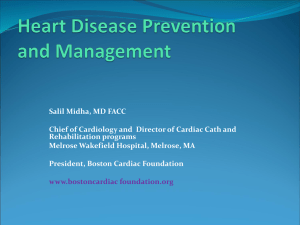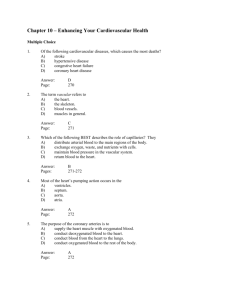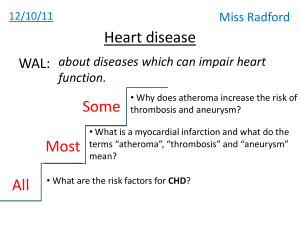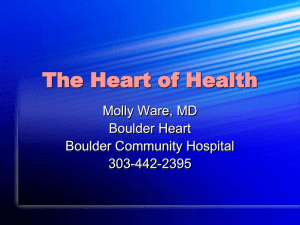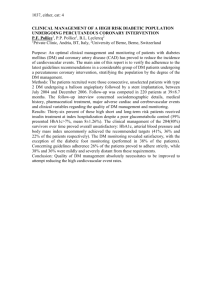Chap10, Ch10
advertisement
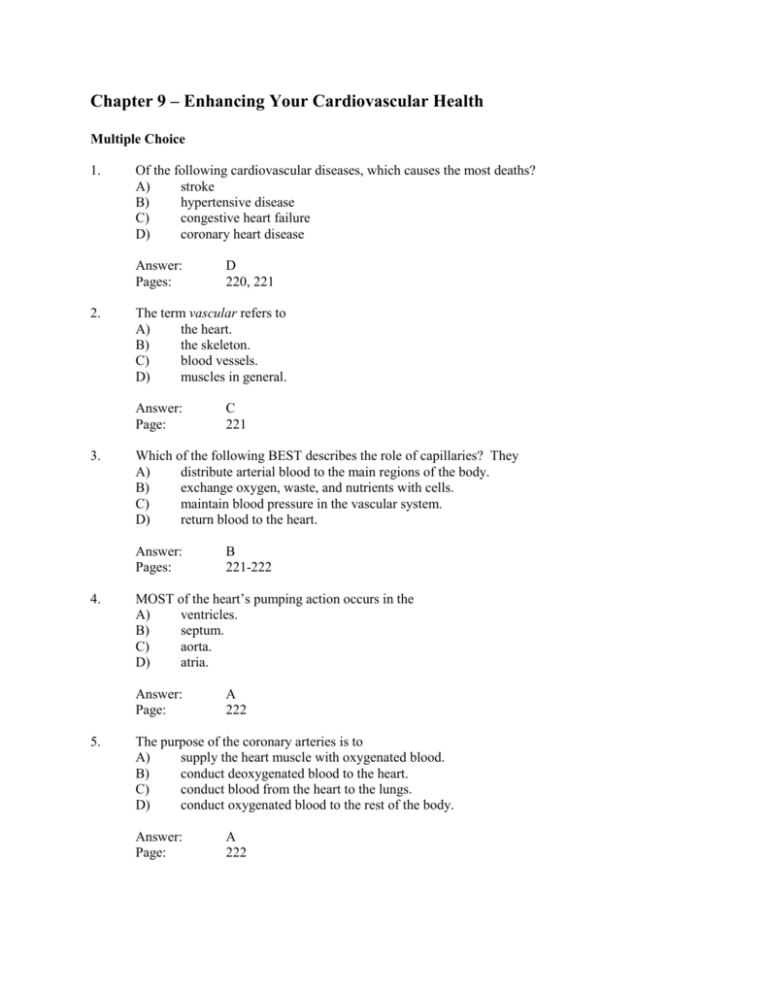
Chapter 9 – Enhancing Your Cardiovascular Health Multiple Choice 1. Of the following cardiovascular diseases, which causes the most deaths? A) stroke B) hypertensive disease C) congestive heart failure D) coronary heart disease Answer: Pages: 2. The term vascular refers to A) the heart. B) the skeleton. C) blood vessels. D) muscles in general. Answer: Page: 3. B 221-222 MOST of the heart’s pumping action occurs in the A) ventricles. B) septum. C) aorta. D) atria. Answer: Page: 5. C 221 Which of the following BEST describes the role of capillaries? They A) distribute arterial blood to the main regions of the body. B) exchange oxygen, waste, and nutrients with cells. C) maintain blood pressure in the vascular system. D) return blood to the heart. Answer: Pages: 4. D 220, 221 A 222 The purpose of the coronary arteries is to A) supply the heart muscle with oxygenated blood. B) conduct deoxygenated blood to the heart. C) conduct blood from the heart to the lungs. D) conduct oxygenated blood to the rest of the body. Answer: Page: A 222 6. About how many quarts of blood does the average-sized adult’s body contain? A) four B) five C) six D) seven Answer: Page: 7. The heart’s electrical activity is measured by an instrument called an A) EEG. B) EKK. C) EKG. D) ECC. Answer: Page: 8. C 223-224 Women over age 55 experience cardiovascular disease at a _________________ rate to men of the same age. A) slightly lower B) much higher C) much lower D) similar Answer: Page: 11. C 223-226 Which of the following cardiovascular risk factors CANNOT be changed? A) diabetes B) high blood pressure C) heredity D) high blood cholesterol Answer: Pages: 10. C 222 The six controllable risk factors for cardiovascular disease are smoking, physical activity, blood pressure, obesity, diabetes, and A) age. B) stress. C) blood cholesterol. D) alcohol consumption. Answer: Pages: 9. B 222 D 224 Of the following, which is a major risk factor in sudden cardiac death? A) diet B) stress C) inactivity D) smoking Answer: Page: 12. The protective mechanism from heart disease women experience prior to menopause is due to A) a lower overall blood pressure. B) a lifestyle healthier than that of men. C) the hormone progesterone. D) the hormone estrogen. Answer: Page: 13. B 226 Tom had his blood cholesterol measured. Which of the following would be classified as a desirable blood cholesterol level? A) less than 200mg/dl B) 210-220 mg/dl C) 230-250mg/dl D) greater than 240 mg/dl Answer: Pages: 16. C 224 The most beneficial way to lower blood cholesterol is to A) take cholesterol-reducing drugs and begin an exercise program. B) start an exercise program and eat a heart-healthy diet. C) eat a diet rich in phytochemicals and meditate. D) eat a low-fat diet and take a vitamin supplement. Answer: Page: 15. D 224 Ellen is thirty-five, inactive, overweight, a smoker, and takes oral contraceptives. The best single thing she can do for her heart health is to A) stop oral contraceptives. B) start an exercise program. C) stop smoking. D) lose weight. Answer: Page: 14. D 224 A 228-229 Coronary heart disease is A) a weakening of the heart valves. B) a buildup of fluids in the pericardial sac. C) damage to the blood vessels that supply the heart. D) a generalized reduction in blood vessel diameter that causes the heart to work harder. Answer: Page: C 227 17. Which of the following is NOT a major form of cardiovascular disease? A) obesity B) stroke C) rheumatic heart disease D) congenital heart disease Answer: Pages: 18. The buildup of fatty deposits in coronary arteries that leads to narrowed arteries and blockages is called A) stroke. B) hypertension. C) atherosclerosis. D) myocardial infarction. Answer: Page: 19. D 227 The death of part of the heart muscle as a result of blockage in one or more of the coronary arteries is known as a A) myocardial inflammation. B) congestive heart infarction. C) myocardial refraction. D) myocardial infarction. Answer: Pages: 21. C 227 A heart attack occurs when A) the heart becomes unable to push blood through clogged arteries throughout the body. B) cardiac muscle loses its ability to conduct electrical stimuli. C) blockages develop in the aorta or pulmonary artery. D) the heart muscle does not receive an adequate supply of blood and oxygen. Answer: Page: 20. A 234-236 D 227-228 You and a friend are shopping with your teenagers at a mall. You return from a store to find your friend seated stating she is feeling chest pain and dizziness. Despite sitting, these symptoms are not going away. The best thing to do at this moment is to A) get emergency help. B) offer her an aspirin before taking other action. C) observe to see if the symptoms last two minutes. D) offer her something to eat to see if the symptoms go away. Answer: Page: A 231 22. The most common symptom of a heart attack is A) shortness of breath. B) dizziness. C) chest pain lasting more than two minutes. D) sweating. Answer: Page: 23. What role does cholesterol play in coronary heart disease? A) High cholesterol levels are associated with atherosclerosis, which causes coronary heart disease. B) Cholesterol attaches itself to internal heart structures, eventually causing blockages. C) Excess cholesterol crowds out the “good” blood cells in coronary arteries. D) Excess cholesterol interferes with the normal functioning of the heart. Answer: Pages: 24. B 229 Which of the following is TRUE regarding low-density lipoproteins? They A) are a significant cause of atherosclerosis. B) carry cholesterol back to the liver. C) are related to a reduction in heart disease. D) are increased in the bloodstream by exercise and monounsaturated fats. Answer: Page: 27. C 229 A painful condition caused by narrowing of the coronary arteries is called A) hypercholesterolemia. B) angina pectoris. C) hypertension. D) angioplasty. Answer: Page: 26. A 228-229 High-density lipoproteins are called “good cholesterol” because they A) coat artery walls with a substance that resists plaque buildup. B) reverse artery damage caused by low-density lipoproteins. C) help to remove cholesterol from the bloodstream. D) absorb low-density lipoproteins. Answer: Page: 25. C 231 A 229 An angiogram is used to A) identify coronary artery blockages. B) gauge the progress of blood through the heart. C) measure the strength of the patient’s heartbeat. D) measure the resistance to blood flow within coronary arteries. Answer: Page: 28. Rolanda’s doctor tells her that something needs to be done to treat life-threatening blockages of several of her coronary arteries. Of the following, her doctor will most likely recommend A) drug therapy. B) bypass surgery. C) an aspirin a day. D) a heart transplant. Answer: Page: 29. C 232 Aspirin’s effect on heart attack risk has traditionally been linked to its ability to A) reduce the blood’s clotting ability. B) reduce stress in people who take it. C) dilate the walls of coronary arteries. D) relax the muscular bands around artery walls. Answer: Page: 32. C 232 In 2007, approximately _________ heart transplants were performed in the United States. A) 200 B) 300 C) 2,000 D) 20,000 Answer: Page: 31. B 232 A procedure to open blocked arteries by squeezing a tiny “balloon” between plaque deposits is called A) coronary occlusion. B) catheterization. C) percutaneous coronary intervention. D) bypass. Answer: Page: 30. A 232 A 233 In a blood pressure reading, the systolic pressure measures pressure in the A) heart when the blood is moving its fastest. B) heart when blood vessels are fully dilated. C) blood vessels when the heart contracts. D) blood vessels when the heart relaxes. Answer: Page: C 233 33. Hypertension is a(n) A) consistently elevated blood pressure. B) abnormal acceleration of the heart rate. C) physiological reaction to a stressful environment. D) constriction of blood vessels due to excess levels of dietary fat. Answer: Pages: 34. Which of the following BEST describes the symptoms of hypertension? A) a pain that begins in the chest or groin and radiates into the limbs B) a feeling of dizziness when under stress C) lack of noticeable symptoms D) excessive fatigue and intermittent dizziness Answer: Pages: 35. D 234 Which of the following is a form of cardiovascular disease? A) stroke B) obesity C) diabetes D) menopause Answer: Page: 38. B 234 Through a combination of weight loss, a low-fat diet, prescription drugs, and an exercise program, your mother has reduced her high blood pressure. When can she consider herself cured? A) when she maintains a normal weight and a normal blood pressure for six months B) when her blood pressure stays at 120/80 for more than six months C) when prescription drugs are no longer needed D) never Answer: Page: 37. C 233-234 Reducing dietary salt is an effective way to reduce hypertension for A) about one in twenty Americans. B) about one in four Americans. C) about one in ten Americans. D) most Americans. Answer: Page: 36. A 233-234 A 234 The most common type of stroke is A) cerebral hemorrhage. B) cerebrovascular occlusion. C) cerebral aneurysm. D) cerebral ischemic attack. Answer: Page: 39. Which of the following characterizes all strokes? A) Blood vessels break. B) Blood flow is blocked. C) They occur in the brain. D) They are preceded by hypertension. Answer: Page: 40. A 235 A transient ischemic attack is considered to be a warning sign for A) congestive heart failure. B) hypertension. C) heart attack. D) stroke. Answer: Page: 43. B 235 Your father, who began to feel ill yesterday, found when he woke up this morning that he could barely move his right leg or arm. Of the following, he is most likely suffering from A) a stroke. B) hypertension. C) a heart attack. D) an arrhythmia. Answer: Page: 42. C 234 A condition called an aneurysm occurs when a A) clot completely blocks blood flow through a cerebral artery. B) weakened artery wall bulges out at the weak point. C) section of brain tissue dies as the result of a stroke. D) weakened artery begins to leak. Answer: Page: 41. B 234 D 235 If a friend or family member has a stroke, it is important to get emergency medical help as soon as possible because A) strokes are usually fatal. B) prompt treatment can limit the damage. C) heart attacks are more likely to occur after strokes. D) rehabilitation should begin as soon as the stroke ends. Answer: Page: B 235 44. Rubella can cause congenital defects in unborn children when A) the mother contracts it during the last three months of her pregnancy. B) the mother contracts it early in her pregnancy. C) it occurs in conjunction with strep throat. D) it develops into rheumatic fever. Answer: Page: 45. The MOST common treatment for congenital heart defects is A) surgery. B) drug therapy. C) diet modification. D) a program of limited activity. Answer: Page: 46. D 236 During a physical examination, your doctor tells you that you may have had a bout of rheumatic fever during childhood. Your doctor probably detected A) an arrhythmia. B) a heart murmur. C) evidence of heart wall damage. D) a minor weakness in the left ventricle. Answer: Page: 49. C 236 The bacteria responsible for rheumatic fever tend to attack the A) muscular walls of the heart. B) coronary arteries. C) pulmonary artery. D) heart valves. Answer: Page: 48. A 236 Which of the following begins as a streptococcal infection? A) peripheral artery disease B) congenital heart disease C) rheumatic heart disease D) congestive heart failure Answer: Page: 47. B 236 B 236 A condition in which blood flow to the legs, feet, and hands is restricted by damaged blood vessels is called A) peripheral artery disease. B) transient ischemia C) D) rheumatic fever. stenosis. Answer: Page: 50. Congestive heart failure occurs when A) excess blood pressure triggers an arrhythmia. B) the ventricles lose their ability to maintain a pumping action. C) the heart lacks sufficient power to maintain adequate circulation. D) the resistance from damaged vessels overstresses the heart, resulting in a heart attack. Answer: Page: 51. C 237 The greatest danger from an arrhythmia is that the A) heart will be unable to deliver enough oxygen to tissues. B) accelerated heart rate of tachycardia will burst brittle arteries. C) heart muscle will suddenly lose its ability to conduct electrical impulses. D) resulting irregular flow of blood will accelerate the blockage of vital arteries. Answer: Page: 54. B 230 Your father is suffering from the early stages of congestive heart failure. Which of the following is recommended? A) restrict all activity B) implant a pacemaker C) dietary modifications D) strict bed rest for two weeks Answer: Page: 53. C 236 The term that describes any of several disorders of the heart’s normal beating pattern is A) fibrillation. B) arrhythmia. C) tachycardia. D) bradycardia. Answer: Page: 52. A 237 A 230 Excessive rapid heartbeat is known as A) bradycardia. B) pradycardia. C) rapacardia. D) tachycardia. Answer: Page: D 230 55. Semone has been diagnosed with peripheral artery disease. Which of the following is NOT considered a treatment? A) stress management techniques B) diet modification C) exercise D) drug therapy Answer: Page: 56. A 237 The research suggests that moderate consumption of alcohol A) appears to lower levels of HDL cholesterol. B) appears to increase levels of LDL cholesterol. C) appears to reduce the risk of coronary heart disease. D) has no effect on the risk of coronary heart disease. Answer: Page: C 233 True/False 57. Cardiovascular disease claims more lives than cancer, accidents, and HIV/AIDS combined. Answer: Pages: 58. The ventricles are the heart’s pumping chambers. Answer: Page: 59. False 222 One of the functions of blood is to maintain proper body temperature. Answer: Page: 61. True 222 The coronary arteries route blood from the heart to the rest of the body. Answer: Page: 60. True 220-221 True 222 High blood pressure is a risk factor for cardiovascular disease that cannot be controlled. Answer: Page: False 226 62. The American Heart Association now recommends that estrogen replacement therapy should not be used for the purpose of preventing cardiovascular disease. Answer: Page: 63. Race is not a factor in determining a person’s risk of cardiovascular disease. Answer: Page: 64. True 229 Most people can lower their serum cholesterol by 75 mg/dl with dietary changes. Answer: Page: 71. True 227 If you are over age 20, you should be concerned if your cholesterol level is 230 mg/dl. Answer: Page: 70. True 226 The deposits on artery walls caused by atherosclerosis are called plaque. Answer: Page: 69. False 229 High blood pressure damages the heart by causing it to enlarge over time. Answer: Page: 68. True 225 A cholesterol level of 240 mg/dl is considered borderline high. Answer: Page: 67. True 224 Recent findings support the contention that physical activity is closely associated with a decreased risk of coronary heart disease. Answer: Page: 66. False 224 Quitting smoking will rapidly reduce your risk of developing heart disease. Answer: Page: 65. True 224 False 229 High HDL cholesterol readings are associated with a reduction in heart disease. Answer: Page: True 229 72. Angina pectoris is caused by a lack of oxygen to the heart tissue. Answer: Page: 73. The purpose of coronary artery bypass surgery is to increase blood supply to the heart muscle. Answer: Page: 74. True 236 Congestive heart failure occurs when the heart is so squeezed by surrounding fatty tissues that blood intake is hampered. Answer: Pages: 81. True 234 A risk factor for rheumatic heart disease is streptococcal infection. Answer: Page: 80. False 234 A type of stroke that results from an artery that bursts is called a cerebral hemorrhage. Answer: Page: 79. True 234 Several drug treatments are available to reduce the outward physical symptoms of hypertension. Answer: Page: 78. False 234 The risk of retinal hemorrhage (uncontrolled bleeding of retinal arteries) increases when hypertension develops. Answer: Page: 77. False 232 The incidence of hypertension is about the same in all ethnic groups. Answer: Page: 76. True 232 Angioplasty is used only for blocked arteries in the heart. Answer: Page: 75. True 229 False 236-237 The person most prone to arrhythmia is one with some form of heart disease. Answer: True Page: 230 Essay 82. List the ten risk factors for cardiovascular disease, and indicate whether they are controllable, uncontrollable, or contributing. Answer: Controllable: hypertension, inactivity, smoking, high cholesterol, diabetes, obesity Uncontrollable: age, gender, heredity Contributing: stress Pages: 83. 223-227 (summarized in Table 9.2, page 223) List and explain the surgical treatments for heart disease. Answer: 1) 2) 3) Pages: 84. The surgical treatments include: coronary bypass surgery, in which the coronary obstruction is bypassed by grafting an artery to the aorta to a location just beyond the coronary obstruction. percutaneous coronary intervention (angioplasty), a procedure in which a coronary catheter is inserted into the narrowed coronary artery and inflated. This inflation opens up the artery by compressing plaque and fatty deposits against the artery wall. heart transplantation, a procedure in which a person’s damaged heart is replaced with that of another human being’s heart. In some instances, artificial hearts have been used as temporary hearts until a suitable donor can be found. 231-233 Briefly describe hypertension and the dangers associated with it. Answer: Hypertension is chronic high blood pressure. The reasons for its occurrence are usually not known. It has no symptoms. Hypertension can weaken both the heart and the blood vessels over time, increasing the risk of heart failure, strokes, and other hemorrhages. Pages: 85. 233-234 List the different kinds of cerebrovascular accidents that are called strokes. Answer: Both blockages (occlusions) and hemorrhages in cerebral arteries are called strokes. Blockages are more common; they occur when a clot prevents blood from reaching an area, causing brain cells to die. Hemorrhage can occur when an artery weakened by hypertension ruptures or when an aneurysm bursts. A third form of stroke is a cerebral aneurysm. An aneurysm is a ballooning or outpouching on a weakened area of an artery. Pages: 234-236 86. List the warning signs associated with stroke. Answer: Although many stroke victims have little warning of an impending incident, the following are warning signs that should be attended to promptly to prevent death or disabling consequences: 1) sudden, temporary weakness or numbness in the face, arm, and leg on one side of the body 2) temporary loss of speech, trouble speaking or understanding speech 3) temporary dimness or loss of vision, particularly in one eye 4) unexplained dizziness, unsteadiness, or sudden falls 5) sudden, severe headache with no known cause Page: 235 (Table 9.7)
